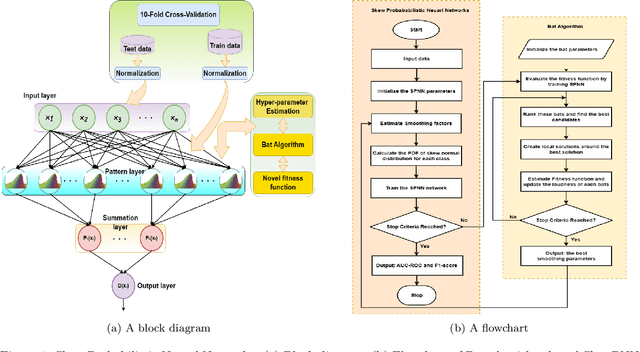Shraddha M. Naik
Skew Probabilistic Neural Networks for Learning from Imbalanced Data
Dec 10, 2023



Abstract:Real-world datasets often exhibit imbalanced data distribution, where certain class levels are severely underrepresented. In such cases, traditional pattern classifiers have shown a bias towards the majority class, impeding accurate predictions for the minority class. This paper introduces an imbalanced data-oriented approach using probabilistic neural networks (PNNs) with a skew normal probability kernel to address this major challenge. PNNs are known for providing probabilistic outputs, enabling quantification of prediction confidence and uncertainty handling. By leveraging the skew normal distribution, which offers increased flexibility, particularly for imbalanced and non-symmetric data, our proposed Skew Probabilistic Neural Networks (SkewPNNs) can better represent underlying class densities. To optimize the performance of the proposed approach on imbalanced datasets, hyperparameter fine-tuning is imperative. To this end, we employ a population-based heuristic algorithm, Bat optimization algorithms, for effectively exploring the hyperparameter space. We also prove the statistical consistency of the density estimates which suggests that the true distribution will be approached smoothly as the sample size increases. Experimental simulations have been conducted on different synthetic datasets, comparing various benchmark-imbalanced learners. Our real-data analysis shows that SkewPNNs substantially outperform state-of-the-art machine learning methods for both balanced and imbalanced datasets in most experimental settings.
Ten Years of Generative Adversarial Nets : A survey of the state-of-the-art
Aug 30, 2023Abstract:Since their inception in 2014, Generative Adversarial Networks (GANs) have rapidly emerged as powerful tools for generating realistic and diverse data across various domains, including computer vision and other applied areas. Consisting of a discriminative network and a generative network engaged in a Minimax game, GANs have revolutionized the field of generative modeling. In February 2018, GAN secured the leading spot on the ``Top Ten Global Breakthrough Technologies List'' issued by the Massachusetts Science and Technology Review. Over the years, numerous advancements have been proposed, leading to a rich array of GAN variants, such as conditional GAN, Wasserstein GAN, CycleGAN, and StyleGAN, among many others. This survey aims to provide a general overview of GANs, summarizing the latent architecture, validation metrics, and application areas of the most widely recognized variants. We also delve into recent theoretical developments, exploring the profound connection between the adversarial principle underlying GAN and Jensen-Shannon divergence, while discussing the optimality characteristics of the GAN framework. The efficiency of GAN variants and their model architectures will be evaluated along with training obstacles as well as training solutions. In addition, a detailed discussion will be provided, examining the integration of GANs with newly developed deep learning frameworks such as Transformers, Physics-Informed Neural Networks, Large Language models, and Diffusion models. Finally, we reveal several issues as well as future research outlines in this field.
 Add to Chrome
Add to Chrome Add to Firefox
Add to Firefox Add to Edge
Add to Edge